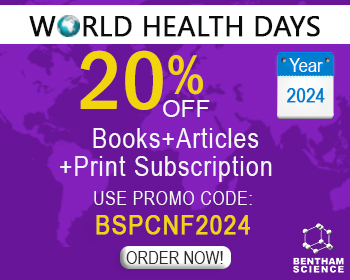Abstract
Background: Pediatric tumors remain the highest cause of death in developed countries. Research on novel therapeutic strategies with lesser side effects is of utmost importance. In this scenario, the role of Renin-Angiotensin System (RAS) axes, the classical one formed by angiotensinconverting enzyme (ACE), Angiotensin II and AT1 receptor and the alternative axis composed by ACE2, Angiotensin-(1-7) and Mas receptor, have been investigated in cancer.
Objective: This review aimed to summarize the pathophysiological role of RAS in cancer, evidence for anti-tumor effects of ACE2/Angiotensin-(1-7)/Mas receptor axis and future therapeutic perspectives for pediatric cancer.
Methods: Pubmed, Scopus and Scielo were searched in regard to RAS molecules in human cancer and pediatric patients. The search terms were “RAS”, “ACE”, “Angiotensin-(1-7)”, “ACE2”, “Angiotensin II”, “AT1 receptor”, “Mas receptor”, “Pediatric”, “Cancer”.
Results: Experimental studies have shown that Angiotensin-(1-7) inhibits the growth of tumor cells and reduces local inflammation and angiogenesis in several types of cancer. Clinical trials with Angiotensin-( 1-7) or TXA127, a pharmaceutical grade formulation of the naturally occurring peptide, have reported promising findings, but not enough to recommend medical use in human cancer. In regard to pediatric cancer, only three articles that marginally investigated RAS components were found and none of them evaluated molecules of the alternative RAS axis.
Conclusion: Despite the potential applicability of Angiotensin-(1-7) in pediatric tumors, the role of this molecule was never tested. Further clinical trials are necessary, also including pediatric patients, to confirm safety and efficiency and to define therapeutic targets.
Keywords: Renin-angiotensin system, cancer, pediatric tumor, angiotensin II, angiotensin-(1-7), angiotensin-converting enzyme, ACE2, angiogenesis.
[http://dx.doi.org/10.1186/s13040-018-0190-8] [PMID: 30675185]
[http://dx.doi.org/10.1016/j.jped.2017.07.008] [PMID: 28888615]
[http://dx.doi.org/10.1186/s40348-018-0084-3] [PMID: 30171420]
[PMID: 30897314]
[http://dx.doi.org/10.1038/ng.2287] [PMID: 22641210]
[http://dx.doi.org/10.1007/s40272-018-0297-x] [PMID: 29948928]
[http://dx.doi.org/10.1126/science.aaw4892]
[http://dx.doi.org/10.1002/mpo.2950160408] [PMID: 3419392]
[http://dx.doi.org/10.1111/bcp.13388] [PMID: 28758697]
[http://dx.doi.org/10.2174/0929867321666140205133357] [PMID: 24524765]
[http://dx.doi.org/10.1007/s00467-011-2002-y] [PMID: 21947887]
[http://dx.doi.org/10.1016/j.phrs.2016.03.018] [PMID: 26995300]
[http://dx.doi.org/10.1074/jbc.M002615200] [PMID: 10924499]
[http://dx.doi.org/10.1161/01.RES.87.5.e1] [PMID: 10969042]
[http://dx.doi.org/10.1073/pnas.1432869100] [PMID: 12829792]
[http://dx.doi.org/10.1016/S0140-6736(98)03228-0] [PMID: 9683206]
[http://dx.doi.org/10.1097/00004872-199606000-00017] [PMID: 8793704]
[http://dx.doi.org/10.1203/01.pdr.0000246100.14061.bc] [PMID: 17065573]
[http://dx.doi.org/10.2174/1389450117666160727142401] [PMID: 27469342]
[http://dx.doi.org/10.1016/S0024-3205(99)00562-7] [PMID: 10658925]
[http://dx.doi.org/10.1007/978-3-030-22696-1_14]
[http://dx.doi.org/10.1200/JCO.2005.06.081] [PMID: 15585754]
[http://dx.doi.org/10.1111/j.1476-5381.2010.00750.x] [PMID: 20590619]
[http://dx.doi.org/10.1053/j.ajkd.2015.10.011] [PMID: 26597926]
[http://dx.doi.org/10.3892/ol.2017.6826] [PMID: 29098020]
[http://dx.doi.org/10.1111/j.1365-2125.2012.04170.x] [PMID: 22243442]
[http://dx.doi.org/10.1152/physrev.00038.2017] [PMID: 29873596]
[http://dx.doi.org/10.2174/1570161043385556] [PMID: 15320819]
[PMID: 10215323]
[PMID: 2579174]
[http://dx.doi.org/10.1152/physrev.00038.2010] [PMID: 21742796]
[http://dx.doi.org/10.1007/s10456-017-9562-9] [PMID: 28660302]
[http://dx.doi.org/10.1016/0196-9781(93)90063-M] [PMID: 8284265]
[http://dx.doi.org/10.1523/JNEUROSCI.3825-10.2011] [PMID: 21451024]
[http://dx.doi.org/10.1016/j.bbrc.2018.05.138] [PMID: 29802847]
[http://dx.doi.org/10.1093/carcin/bgh236] [PMID: 15284177]
[http://dx.doi.org/10.1097/j.pain.0000000000000690] [PMID: 27541850]
[http://dx.doi.org/10.2106/JBJS.O.00545] [PMID: 26738903]
[http://dx.doi.org/10.7759/cureus.3286] [PMID: 30443456]
[http://dx.doi.org/10.1007/s00432-015-1974-6] [PMID: 25910988]
[http://dx.doi.org/10.1038/nrc2945] [PMID: 20966920]
[http://dx.doi.org/10.1007/s00280-002-0434-6] [PMID: 11976835]
[http://dx.doi.org/10.1007/s00280-002-0509-4] [PMID: 12647010]
[http://dx.doi.org/10.1158/0008-5472.CAN-06-3614] [PMID: 17363603]
[PMID: 9731479]
[http://dx.doi.org/10.1093/carcin/bgl055] [PMID: 16675471]
[http://dx.doi.org/10.3892/or.9.4.693] [PMID: 12066194]
[http://dx.doi.org/10.1186/ar609] [PMID: 12716442]
[http://dx.doi.org/10.1158/1535-7163.MCT-09-0161] [PMID: 19509262]
[http://dx.doi.org/10.1371/journal.pone.0190204] [PMID: 29261785]
[http://dx.doi.org/10.1007/s11010-017-3229-0] [PMID: 29204818]
[http://dx.doi.org/10.1158/0008-5472.CAN-10-1136] [PMID: 20837666]
[http://dx.doi.org/10.1016/j.canlet.2016.04.006] [PMID: 27063099]
[http://dx.doi.org/10.18632/oncotarget.19290] [PMID: 29179450]
[http://dx.doi.org/10.1002/pros.22540] [PMID: 22644934]
[http://dx.doi.org/10.1002/pros.22542] [PMID: 22644942]
[http://dx.doi.org/10.2119/molmed.2015.00022] [PMID: 26225830]
[http://dx.doi.org/10.7150/ijbs.22235] [PMID: 29483825]
[http://dx.doi.org/10.3892/or.2015.3813] [PMID: 25708368]
[http://dx.doi.org/10.1007/s12253-018-0471-z] [PMID: 30229380]
[http://dx.doi.org/10.1158/1078-0432.CCR-09-1957] [PMID: 19920106]
[http://dx.doi.org/10.1007/s00280-005-0078-4] [PMID: 16096787]
[http://dx.doi.org/10.1007/s00280-013-2089-x] [PMID: 23370663]
[http://dx.doi.org/10.1002/pbc.20938] [PMID: 16794999]
[http://dx.doi.org/10.1016/j.jaad.2015.09.061] [PMID: 26685718]
[http://dx.doi.org/10.14814/phy2.12728] [PMID: 26997629]
[http://dx.doi.org/10.1016/0022-3468(72)90215-1] [PMID: 4343314]
[http://dx.doi.org/10.7326/0003-4819-11-9-1613]
[http://dx.doi.org/10.1016/j.bjps.2010.08.039] [PMID: 20870476]
[http://dx.doi.org/10.1111/j.1365-2133.2012.11016.x] [PMID: 22533490]
[PMID: 25196392]
[http://dx.doi.org/10.1146/annurev-physiol-012110-142238] [PMID: 20936939]




























